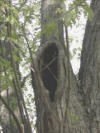|
Raccoon weights vary from region to region. Generally, raccoons attain larger weights in northern states and lighter weights in southern states. Most adult male raccoons in northern states weigh 15-18 pounds during fall harvest seasons, with females averaging 2-3 pounds less. Occasional specimens in northern states may weigh 30 pounds. Raccoons have 40 teeth, including 4 elongated and sharp canine teeth. The hind legs of the raccoon are longer than the front legs, giving them a hunched appearance as they walk or run. They have five toes on each foot and the front feet are dexterous, allowing the raccoon to grasp and clutch items. The fur of raccoons has guard hair of 2-2 1/4 inches long on the back areas, and the fur is 1 1/2" or 1 3/4" long and dense. Fur colors vary in areas and from season to season. Several diseases afflict raccoons, including both canine and feline distemper. Raccoons occasionally carry leptospirosis, which can be transmitted to humans via biting. Rabies is also a problem in raccoons and this species is the leading carrier of this dreaded disease in some eastern and southeastern states. Parasites infecting raccoons include roundworms, flatworms, and tapeworms. Reproduction Breeding seasons for raccoons are usually in January in southern states, and February in the middle and northern states. Young males are evicted from the dens at this time and mature male raccoons search out all available females. Female raccoons are capable of breeding at 10 months of age, but males do not breed until their second year of life. Gestation is usually 63 days. Litters of 4-6 are common in northern states. The young raccoons are cared for solely by the mothers and the mother raccoons are aggressive in the protection of their young. Habits Raccoons eat a wide variety of foods, They store up layers of fat during the fall to prepare for winter. Contrary to common beliefs, raccoons do not hibernate during extreme weather, but they do stay in dens for weeks at a time using up stored body fats. In southern states, raccoons may stay active all winter. Raccoons are very strong animals and both good swimmers and good tree climbers. When climbing a tree, a raccoon will usually climb in a hand over hand fashion, but they are capable of bounding up a tree. Raccoons descend trees either by backing down or turning around and coming down head first. The front paws of raccoons are very dexterous and the species commonly hunt in shallow water by turning over stones in search of crayfish and other foods. Raccoons are opportunists, commonly eating whatever is available. Important foods include crayfish, mussels, clams, frogs, salamanders, earthworms, fruits, nuts, grains, carrion, eggs, and any available warm blooded small mammals or birds. Preferred foods may include fish and sweet corn. Territory sizes vary with individual raccoons and most home ranges seem to cover 2-4 square miles. The shapes of the territories are irregular and usually include the waterways within the area. Raccoon do a significant amount of their hunting in or around water and preferred habitats include a stream, pond or marsh in the area. A raccoon may cover as much as 3-5 miles on mild fall nights and eat as much as 5 pounds of food while storing up body fat for winter. Usually, the raccoon will den up for the day at a convenient den. General The raccoon does not compete severely with other species in the demands upon the habitat. Many species can and do share the same areas with raccoons with a minimum of friction. Raccoons can cause damage at times, especially when they are abundant. Waterfowl nests are raided regularly for eggs and raccoons sometimes raid farmyards for chickens or other fowl. Corn in the milk stage is vulnerable to raccoons and they find sweet corn particularly attractive. The damage to sweet corn by raccoons can be extensive, as this species commonly wastes more sweet corn than it eats. Adult raccoons are sometimes preyed upon by coyotes, bobcats, and mountain lions where ranges overlap. Juvenile raccoons are also killed at times by large owls, and eagles. Ten years of age is considered old for a wild raccoon. RETURN TO TOP |


